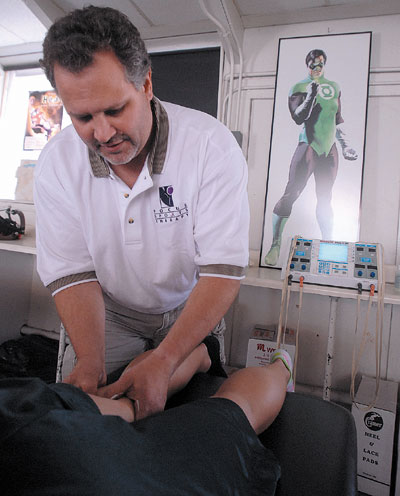
The students in Sports Medicine I at San Benito High School have
an assignment due in one month. Teacher and certified trainer Dave
Tari assigned his class to take a particular position in any sport
and then design a training program specific to that position for
in-season, postseason, off-season and preseason workouts.
The students in Sports Medicine I at San Benito High School have an assignment due in one month.
Teacher and certified trainer Dave Tari assigned his class to take a particular position in any sport and then design a training program specific to that position for in-season, postseason, off-season and preseason workouts.
“I want to see an understanding of each season, with a changing of exercises,” Tari said. “I’m hoping they’ll make it a lifelong goal.
“As far as exercising goes, you have to have the drive and determination to do it. Half the battle is getting your butt down there (to the gym).”
It’s no secret that sports at the high school level are year-round nowadays, as competition increases and the postseason stakes rise. The notion of three-sport athletes reigning supreme has more or less been replaced by a generation of one-sport athletes who devote their attention to a single activity through club teams and offseason training year-round. Some coaches implement offseason training exercises to see their players come into camp healthy and in shape.
With performance-enhancing drugs in and out of the news, and diabetes on the rise in children and adolescents, physical fitness is, perhaps, more important now than it ever has been.
Since 2000, coach and P.E. teacher Randy Logue has seen an emphasis by the state on the results of its physical fitness testing, which monitors students in six tests, including a body mass index, a mile run, a push-up test, a sit-and-reach test, a trunk lift and curl-ups.
Results are taken when the students are in the fifth, seventh and ninth grade, while SBHS continues the testing through the 10th, 11th and 12th grades in order to monitor progress.
The high school also tests its students in the shuttle run.
“We’re mean,” joked Logue.
After the results are submitted, the state returns a progress report for each individual student.
“There are state standards in P.E. just like in any other class now,” said Logue, who’s taught for 22 years at SBHS. “The goal is to help each kid develop a personal fitness plan. The hope is that the kids taking those results take pride in it and address weaknesses they have.”
Logue and others look to teach a range of different physical activities, proper basic exercises and positive healthy habits.
Logue added that in 2007, 40 percent of SBHS students passed all six tests, a figure well above the 29.6 percent state average, while 70 percent at SBHS passed five of the six tests.
Said Logue of the changes he’s seen in physical education, “Data is the big buzzword.”
Data in training – ‘the big buzzword’
Data has become the prevalent measuring stick in nutrition, too, as the United States Department of Agriculture replaced the food pyramid in 2005 and introduced a new, personalized pyramid that stresses physical activity and moderation within the individual food groups.
The new pyramid, known as MyPyramid, hangs in Tari’s classroom on the SBHS campus, and he says that coaches today are really pushing nutrition more.
Just last year, the vending machines at SBHS stopped selling soda and instead sell water, juice and sports drinks that are low in sugar.
“I’m happy (Gov. Arnold) Schwarzenegger got rid of soda in high schools,” Tari said. “We’re seeing the effects of soda, of junk food, and we have a lot more concerns with that.
“If we can start making some changes with diet, that’d be huge.”
One freshman who was tested at SBHS had 33 percent body fat. Said Tari, “That kills me.”
“It was hypocrisy in essence,” Logue said. “We tell the kids to get in shape, but then we sell them junk food.”
With an added emphasis on teaching students what goes into their bodies, the elephant in the room recently has been performance-enhancing drugs.
In Tari’s Sports Medicine I class – with approximately 30 kids – students believed that 50 percent to 60 percent of athletes, in general, use PED’s, whereas they believed four or five people at SBHS are using performance-enhancers.
“I know if someone offered me steroids back then, and it would have guaranteed me a scholarship, I would have (taken them),” Tari said. “But now knowing what we know, I wouldn’t do it, and I think kids are more intelligent now.”
With students at school for only part of the day, however, Tari said the message on fitness and nutrition needs to continue at home as well.
Ramona Trevino, who teaches moderately to severely disabled students at SBHS, is trying just that.
Trevino has taught her students to watch what they eat – “Living long and being strong,” she said – and has extended her classroom lessons to the home by having students and parents log dinner meals and water intake.
“Part of my plan this year is whatever we’re enforcing here at school will go home,” Trevino said, “so the parents can see what they’re eating at home.
“When they see the numbers, it’s more real.”









